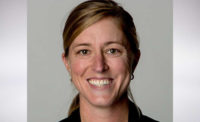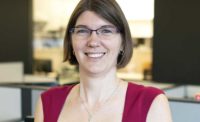Name/Title/Company: Michelle Jamshidi, design department manager, PEG LLC
Age: 29
Educational Experience: Bachelor’s degree in mechanical engineering, minor in sustainable design, West Virginia University
Professional Credentials/Accreditations: Engineer in Training (EIT), Leadership in Energy and Environmental Design (LEED) Green Associate (GA)
Organizational Affiliations/Achievements/Awards: ASHRAE member, Leadership Fairfax (ELI)
What does your day-to-day job entail?
As the design department manager, I oversee all of our mechanical, electrical, and plumbing (MEP) projects. I coordinate with clients on residential and commercial buildings to deliver energy-efficient designs. I review and redline projects to confirm all aspects of the design meet our company standards, comply with code, and exceed clients’ expectations. Depending on my schedule, I sometimes still do HVAC designs from start to finish, which includes running the load calculations, designing ductwork, and drafting in AutoCAD.
What caused you to/when did you fall in love with engineering?
In high school, we had a field trip to the national mall in Washington, D.C., where the U.S. Department of Energy’s Solar Decathlon was held. Universities from all over the country competed to design and build a net-zero, sustainable home. I remember touring each house and being in awe of what these college students were able to create. Each home was unique with features, such as passive cooling designs, gray water filtration systems, reclaimed materials, and smart home technologies. From then on, I knew what path I wanted to take. I knew I was destined to be an engineer. My junior year of college, I joined my university’s Solar Decathlon team, where I helped build a net-zero home. I was part of the mechanical team that designed the home’s HVAC system, which included a passive cooling approach. The entire experience was so rewarding, and it really guided me to my career in HVAC.
What has been the most rewarding/proudest aspect of your engineering career?
Being able to see my designs as a finished product is incredibly rewarding. One of my first projects was close to where I live, and I would drive by it several times throughout construction to see its progress. It’s fun to be able to help create something from nothing and see the physical result.
What challenges do women face in this profession? Can you give a personal example? Why aren’t there more women in engineering? How can we increase the number of women in engineering?
Personally, I have faced a few challenges in this field. When I was in grade school, I was told that engineering is a weird major for a girl to choose. Then, when I got to college, I had several classes where I was the only woman in the room. I always felt like I had to work harder to prove that I belonged and deserved to be there. I have had several instances where I would answer someone’s question only to find out that they went around and asked a male counterpart the same question because they didn’t trust my expertise.
I think engineering wasn’t always showcased as a viable career option to young women. There are so many different types of engineering jobs, and people might not realize all the options out there.
My old high school started a STEM program not long after I graduated, and I think that is one of the best ways to get young women on the path to engineering. STEM programs open the door to more opportunities and really demonstrate all that engineering and science careers have to offer.
How many years have you been active in the engineering sector? What’s changed the most in that time? What’s changed the least?
I have been working in this industry for five years now. In that time, I have seen a few shifts and changes in HVAC design. In residential, newer codes and energy requirements mean houses are being built tighter. This is pushing builders to use better ventilation strategies, and we are seeing more energy recovery ventilators (ERVs) being put into homes. The change from SEER to SEER2 that occurred in the beginning of 2023 increased the minimum efficiency of the air conditioners and heat pumps being installed.
You serve as a senior leader in a woman-owned and operated firm. Tell us why this is so significant.
As more women are being encouraged into STEM fields, our firm is at the forefront of bringing women into leadership roles in a male-dominated field. Having a role model, like JoAnn Spence, president and CEO of PEG, has helped pave the way for more women, like myself, to bring new perspectives and innovative ideas to our work.
You’ve published papers on the future role of natural gas in the global economy. Can you summarize your thoughts on the subject?
I have no doubt that renewable energy is the future, but, in the meantime, natural gas is an integral resource and the next step to achieving energy sufficiency. The U.S. ranks fourth in natural gas reserves with our exports increasing exponentially over the last two decades. As coal-fired power plants reach the end of their life spans, we will see natural gas take its place. Already, 38% of natural gas consumption is for electric power, and 15% is residential. While gas companies are still offering rebates and incentives to new construction builders, legislature in several states, such as California and New York, are banning new lines from being installed. In the long term, we will see renewable energies rising in production, but, in the meantime, natural gas isn’t going away any time soon.
What drives/motivates you every day?
I like to think of the projects I work on as puzzles that need to be solved. I enjoy a challenge and seek out opportunities to learn something new.
What remains on your engineering bucket list — what do you aspire to do that you haven’t accomplished yet?
The next step for me is getting my professional engineering (P.E.) license. This is something I have aspired to achieve since starting my career. I am looking forward to the satisfaction of stamping my own designs.
What’s one thing no one knows about you?
I live on a farm and take care of goats, llamas, chickens, peafowl, guineas, and bees. I’ve won two blue ribbons at the Virginia State Fair for baking and one at the Fredericksburg Fair for my honey. I love learning new things, such as beekeeping, cheese making, and getting my motorcycle license (even if I never intend to ride again).
List any mentors who’ve helped you succeed and describe precisely how they’ve shaped your success.
My college advisor, Dr. James E. Smith, had a big impact on my success. He pushed me out of my comfort zone and helped me develop leadership skills. He and I co-wrote a couple of papers for publication, which is something I never would have thought to do on my own. He saw a leader in me and helped me gain confidence and take control of my future to become who I wanted to be.
My supervisor, Matthew Cooper, has also been a big supporter and mentor for me. He is always encouraging me to take extra courses to expand my technical knowledge and improve my management skills. I wouldn’t be in the position I am today without his guidance.
What advice do you have for prospective female engineers considering entering the field?
Don’t be afraid to ask questions. You can learn so much from other people’s experiences and perspectives. When someone asks you a question you don’t know the answer to, take it as a learning opportunity.





